Single Photon Detectors
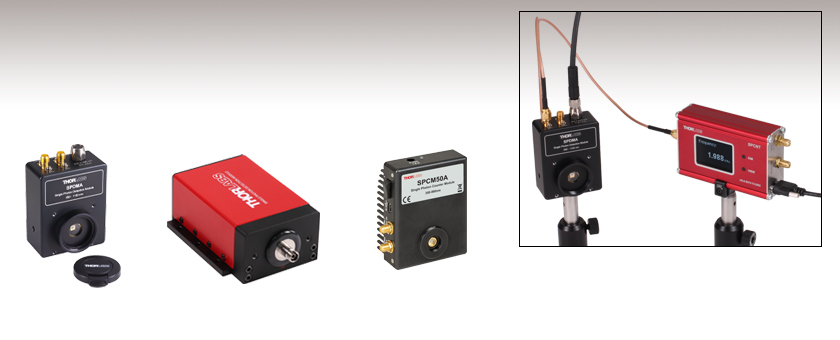
- Single Photon Detection or Counting Modules
- Low Max Dark Counts: 60 Hz - 1500 Hz
- Detector Sizes of Ø20, Ø50, Ø100, or Ø500 µm
- Active Quenching and Temperature Stabilization
SPCM50A
Single Photon Counting Module
SPDMA
Single Photon Detection Module with Adjustable Gain
SPDMH2F
Single Photon Detection Module with Fixed Gain, FC/PC Connector
Application Idea
Single Photon Counting Device Counts Pulses from the SPDMA Detection Module

Please Wait
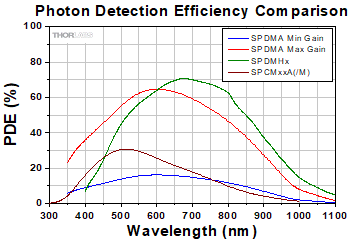
Click to Enlarge
The Photon Detection Efficiency (PDE) is shown here as a function of wavelength for the SPDMA module at both Max and Min Gain, the SPDMHx modules, and the SPCMxxA(/M) modules. The operating range of the SPDMA module is 350 nm - 1100 nm, for the SPDMHx modules it is 400 nm - 1000 nm, and the operating range of the SPCMxxA(/M) modules is 350 nm - 900 nm.
Applications
- Spectroscopy with Single Molecules
- Spectro-Photometrical Measurements
- Flow Cytometry
- Photon Correlation Spectroscopy
- Quantum Optics
- LIDAR
Features
- Single Photon Detection or Counting Modules
- Visible and NIR Wavelength Responsivity
- Low Max Dark Count Rates: 60 Hz - 1500 Hz
- Four Detector Sizes: Ø20 µm, Ø50 µm, Ø100 µm, or Ø500 µm
- Active Quenching
- Temperature Stabilization
- Pulse Output
- TTL Gating/Trigger Input
- Single Photon Counting Device for use with Detection Modules
Thorlabs offers single photon detectors and counting modules with a range of photon detection efficiencies (PDEs), detector sizes, gain options, and wavelength ranges. The SPDMA Single Photon Detection Module, designed for use from 350 to 1100 nm, features continuously adjustable gain and an SMA electrical connector from which the TTL output can monitored by an oscilloscope or external counter. Comparatively, the SPDMHx Fixed-Gain Single Photon Detection Modules, for use from 400 to 1000 nm, combine a higher PDE in the NIR (see the graph to the right) with low maximum dark count rates; the output TTL pulses are accessible via a LEMO connector.
The SPCNT Single Photon Counting Device can be used in conjunction with either the SPDMA detector or SPDMHx series of detectors to provide a full detection and counting solution. The counting device recognizes signal pulses originating from a connected single photon detector and shows the results numerically as counts or frequency on the built in display, or on a connected PC for display and analysis. The device can be controlled by the Optical Power Monitor (OPM) software when connected to a PC, see the Software tab for details.
Finally, the SPCMxxA(/M) Single Photon Counting Modules have an internal 31-bit photon counter, include a software package for controlling the detector and reading the output, and are intended for use from 350 to 900 nm. A comparison of the PDEs of the detectors is shown at right.
Each single-photon detector or module uses a silicon avalanche photodiode (see the Tutorial tab for a description of the operating principle). The active quenching circuit integrated into the diode of these single photon detection systems enables high count rates, allowing users to detect a photon every 35 ns - 45 ns, depending on the model chosen. The diodes are actively temperature stabilized to achieve low maximum dark count rates of 60 Hz - 1500 Hz, depending on the model and settings, with power level detection down to fW. Please see the Specs tab for complete specifications on all modules.
For detectors that offer an array of silicon avalanche photodiodes for low light and single photon detection, Thorlabs offers a series of silicon photomultipliers as well.
Software for SPCMxxA(/M) Counting Modules
The Single Photon Counter Modules include a software package with GUI for out-of-the-box operation. The following operating modes can be set by the software:
- Manual Mode for manual operation, where the counter is started and stopped manually by pressing the Start/Stop button (toggle function).
- Free Running Timer Counter for counting incident photons for a certain number of "Time Bin Lengths."
- Externally Triggered Timer Counter for triggering the timer start for counting incident photons for a certain time period.
- Externally Triggered Counter for starting and stopping the counter by an external trigger.
- External Gating for activating the counter and the APD externally.
For more details about the software and its operation modes, please see the Software tab.
| Detector Key Specificationsa | |||||||
|---|---|---|---|---|---|---|---|
| Item # | SPDMA | SPDMH2 | SPDMH2F | SPDMH3 | SPDMH3F | SPCM20A(/M) | SPCM50A(/M) |
| Type | Single Photon Detection Module | Single Photon Detection Module | Single Photon Counting Module | ||||
| Wavelength Range | 350 - 1100 nm | 400 - 1000 nm | 350 - 900 nm | ||||
| Dark Count Rate | @ Min Gain: <75 Hz (Typical); <400 Hz (Max) @ Max Gain: <300 Hz (Typical); <1500 Hz (Max) |
100 Hz (Max) | 250 Hz (Max) | 25 Hz (Typical) 60 Hz (Max) |
150 Hz (Typical) 200 Hz (Max) |
||
| Active Detector Size | Ø500 µm | Ø100 µmb (Nominal) | Ø20 µm | Ø50 µm | |||
| Connector Style | Free Space | Free Space | FC/PC | Free Space | FC/PC | Free Space | Free Space |
| Software | No | No | Yes | ||||
| SPCNT Device Compatible | Yes | No | |||||
| Item # | SPDMA | SPDMH2 | SPDMH2F | SPDMH3 | SPDMH3F | SPCM20A(/M) | SPCM50A(/M) |
|---|---|---|---|---|---|---|---|
| Detector | |||||||
| Detector Type | Si Avalanche Photodetector | ||||||
| Wavelength Range | 350 nm - 1100 nm | 400 nm - 1000 nm | 350 nm - 900 nm | ||||
| Active Detector Size | Ø500 µm | Ø100 µma (Nominal) | Ø20 µm | Ø50 µm | |||
| Gain Adjustment Factor (Typical) | 4 | N/A | N/A | ||||
| Typical Photon Dectection Efficiency | @ Max Gain 58% @ 500 nm 66% @ 650 nm 43% @ 820 nm |
10% @ 405 nmb 50% @ 520 nmb 70% @ 670 nmb 60% @ 810 nmb |
35% @ 500 nm | ||||
| PDE Variation at Constant Temperature (Typical) | N/A | ~1% | ~5% | ~1% | ~5% | N/A | |
| Dark Count Rate | @ Min Gain: <75 Hz (Typical); <400 Hz (Max) @ Max Gain: <300 Hz (Typical); <1500 Hz (Max) |
100 Hz (Max) | 250 Hz (Max) | 25 Hz (Typical); 60 Hz (Max) |
150 Hz (Typical); 200 Hz (Max) |
||
| Count Rate | @ Max Gain: 20 MHz (Typical); >10 MHz (Min) |
20 MHz (Max) | 28 MHz (Max) | 22 MHz (Max) | |||
| Timing Resolution (Typical) | N/A | 1000 ps | N/A | ||||
| Dead Time | <35 ns (@ Max Gain) | 45 ns (Typical) | 35 ns (Typical) | 45 ns (Typical) | |||
| APD Gating Delayc | N/A | N/A | 18 ns (Typical) | ||||
| Gate / Trigger In to Pulse Out Delayd | N/A | N/A | 28 ns (Typical) | ||||
| Delay Between Photon Impact and TTL Pulse (Typical) |
N/A | 30 ns | N/A | ||||
| Afterpulse Probability | 1% (Typical @ Min Gain) | 0.2% (Typical) | 3% | ||||
| APD Temperature Stability | <0.01 K | N/A | <0.1 K | ||||
| Trigger Input TTL Signal Low (Closed) High (Open) |
<0.8 Ve >2 Ve |
0.5 Vf 2.4 Vf |
<0.8 V >2 V |
||||
| Trigger Input Response Time Closing Signal Opening Signal |
N/A N/A |
15 ns (Typ) to 20 ns (Max) 60 ns (Typ) to 65 ns (Max) |
N/A N/A |
||||
| Output Pulse Width @ 50 Ω Load | 10 ns (Min); 15 ns (Typ); 20 ns (Max) |
15 ns (Typ); 17 ns (Max) | N/A | ||||
| Output Pulse Amplitude @ 50 Ω Load TTL High TTL Low |
3.5 V 0 V |
3 V (Typical) N/A |
3.5 V 0 V |
||||
| SPCNT Counting Device Compatible | Yes | No | |||||
| Input Fiber Compatibility | |||||||
| Fiber Connector | N/A | N/A | FC/PC | N/A | FC/PC | N/A | |
| Input Fiber Core Diameter (Max) | N/A | N/A | <105 μm | N/A | <105 μm | N/A | |
| Numerical Aperture (NA) | N/A | N/A | ≤0.29 | N/A | ≤0.29 | N/A | |
| General | |||||||
| Dimensions (W x H x D) | 72.0 x 51.3 x 27.4 mm (2.83'' x 2.02'' x 1.08'') |
105.6 x 40.1 x 76.0 mm (4.16'' x 1.58'' x 2.99'') |
116.0 x 40.1 x 76.0 mm (4.57'' x 1.58'' x 2.99'') |
105.6 x 40.1 x 76.0 mm (4.16'' x 1.58'' x 2.99'') |
116.0 x 40.1 x 76.0 mm (4.57'' x 1.58'' x 2.99'') |
85.0 x 76.5 x 36.2 mm (3.35" x 3.0" x 1.43") |
|
| Operating Temperatureg | 0 °C to 35 °C | 10 °C to 40 °Ch | 0 °C to 40 °C | ||||
| Storage Temperature Range | -40 °C to 70 °C | -20 °C to 70 °C | -40 °C to 70 °C | ||||
| Power Supply | ± 12 V, 0.3 A / 5 V, 2.5 A | 12 V, 0.8 A | 6 VDC / 1.5 A | ||||
| Power Supply for Operation @ 1 MHz | N/A | 12 V, 0.2 A | N/A | ||||
Operating Principle of Single Photon Detectors
Avalanche photodiodes (APDs) operated in the Geiger Mode have the ability to detect single photons. This single photon sensitivity can be achieved by biasing the APD above the breakdown voltage (Point A in Fig. 1). The APD will remain in a metastable state until a photon arrives and generates an avalanche (Point B). This avalanche is quenched by an active quenching circuit inside the APD (Point C), which lowers the bias voltage below the breakdown voltage (labeled VBR in Fig. 1).
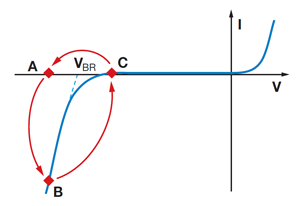
Figure 1: Current Voltage Characteristics of an Avalanche Photodiode Operated in Geiger Mode
Afterwards the excess bias voltage can be restored. During this time, which is known as the pulse dead time of the diode, the APD is insensitive to any other incoming photons. Spontaneously triggered avalanches are possible while the diode is in a metastable state. If these spontaneous avalanches occur randomly, they are called dark counts. If the spontaneously triggered avalanches are correlated in time with a pulse caused by a photon, it is called an afterpulse. To block such afterpulses in the measurement, an additional pulse dead time can be set in the software for the counting modules, which will cause the internal counter of the single photon detector to ignore all pulses occurring during this pulse dead time.
Definitions
Geiger Mode:
In this mode, the diode is operated slightly above the breakdown threshold voltage. Hence, a single electron-hole pair (generated by absorption of a photon or by a thermal fluctuation) can trigger a strong avalanche.
Dark Count Rate:
This is the average rate of registered counts in the absence of any incident light and determines the minimum count rate at which the signal is dominantly caused by real photons. The false detection events are mostly of thermal origin and can therefore be strongly suppressed by using a cooled detector.
Active Quenching occurs when a fast discriminator senses the steep onset of the avalanche current and quickly reduces the bias voltage so that it is below breakdown momentarily. The bias is then returned to a value above the breakdown voltage in preparation for detection of the next photon.
Dead Time is the time interval the detector spends in its recovery state. During this time, it is effectively blind to incoming photons. The dead time fraction, which is an inherent feature of an active quenching circuit, may be defined as the ratio of missed to incident events.
Afterpulsing:
During an avalanche, some charges can be trapped inside the high field region. When these charges are released, they can trigger an avalanche. These spurious events are called Afterpulses. The life of those trapped charges is on the order of a few tenths of a microsecond. Hence, it is likely that an afterpulse occurs directly after a signal pulse.
Software for SPCMxxA(/M) Counter Modules
Version 1.1
Click the button below to visit the software page for these Single Photon Counters.
Software for SPCMxxA(/M) Counting Modules
The SPCMxxA(/M) Single Photon Counting Modules include a software package with GUI for out-of-the-box operation. Please note the SPDMA and SPDMHx Single Photon Detectors do not include or require any software for operation.
The following operating modes can be set by the software:
Manual Mode:
The counter is started and stopped manually by pressing the Start/Stop button (toggle function). The timer will be reset at each start.
Free Running Timer Counter:
Both the number of time bins (i.e, the number of measurements) as well as the minimum interval between two subsequent bins can be set.
Externally Triggered Timer Counter:
In this mode, the timer is started by an external trigger signal and counts incident photons during the set time bin length. The active trigger slope (rising or falling) can be selected.
Externally Triggered Counter:
In this mode, the external trigger signal will start and stop the counter.
External Gating:
The counter and the APD are activated externally.
Measurement Settings:
In the array mode, each data value is recorded to an array. In the continuous mode, the measurement is restarted after the preset number. Both modes can be saved as a .txt file. The measurement results can be represented as a bar (XY bar with counts vs. number of measurements), graph (curve), table (numeric) or alignment (numeric with additionally information) display. The number of measurements can be defined, and the measurements can be repeated.
OPM Software for SPCNT Counter
Version 5.1 (February 23, 2024)
Click on the link below to download the Optical Power Meter (OPM) Software.
Optical Power Meter GUI Software for the SPCNT Counter
Features
- Record and Analyze Measurements in Real Time
- Intuitive Numeric Display and Graphing Modes
- Configurable Long-Term Data Logging
- Connect up to 8 SPCNT Counters in Parallel
Multiple data measurement and analysis functions are integrated into the GUI package. The interface offers a user-friendly design with minimal use of color and low brightness that is ideal use in dark lab environments while wearing laser safety glasses. Measured data can be displayed in real time as digital values or a line graph. Continuously logged and short-term measurements can be recorded for data viewing and analysis at a later point. A built-in statistics mode analyzes measured data and continuously updates to reflect new measurements within the pre-determined measurement period.
The Optical Power Monitor software package installs the GUI, which then can be used to control the USB-interface SPCNT console. Programming examples and drivers for interfacing with all supported devices using LabVIEW, C/C++, Visual C#, and Python are installed with the software; refer to the OPM manual for details.
| Posted Comments: | |
Dibyendu Sasmal
(posted 2024-04-03 02:26:33.44) Hi, I am looking for fast detector with 50 ps (FWHM) resolution for the application of single-molecule fluorescence spectroscopy, FCS, smFRET etc. The detection range should be within VIS range. Dark count should low (~100 cps). Please suggest a suitable detector. dpossin
(posted 2024-04-03 09:09:53.0) Dear Dibyendu,
Thank you for your feedback. I don´t think that single photon counters are the right device for your application. I rather recommend to have a look at our ultrafast photodetectors instead (https://www.thorlabs.de/navigation.cfm?guide_id=2558) I reach out to you directly in order to discuss that through. Soo Lee
(posted 2023-02-24 15:08:01.503) We are trying to run the SPCM20 unit via labview, but having trouble here. When I try to run the labview vi, I get the pop-up that asks for 'TLSPCM_Drv_32.dll' But I cannot locate this anywhere. Could you help? Your help is greatly appreciated. GBoedecker
(posted 2023-02-27 11:07:13.0) Thank you very much for your feedback! You can change the library path to in the VIs to C:\Program Files (x86)\IVI Foundation\VISA\WinNT\Bin\TLSPCM_32.dll. We will update the VIs in the download folder. Liam Bradshaw
(posted 2022-09-27 07:56:58.917) Is it possible to get stand-alone photon counting electronics, similar to those in your SPCM50 detector but for use with an external detector? Ideally, I would also love to have an analog output proportional to the number of counts over a certain (adjustable) time window that could be fed into a lock-in amplifier. soswald
(posted 2022-10-04 09:09:20.0) Dear Liam,
thank you for your feedback. I have reached out to you directly to discuss your application in more detail. Viktor Dremin
(posted 2022-08-23 09:02:48.977) Hi, are there any plans to offer single photon detectors for the NIR range? soswald
(posted 2022-08-24 03:17:03.0) Dear Viktor,
thank you for your feedback. We are constantly looking into expanding our product portfolio.
As we believe NIR single photon detectors to be a valuable tool for the quantum technology community, these are certainly among future products we are considering.
At the moment we do not have a definitive timeline for a product development, though. Kshitija MIrkale
(posted 2022-05-17 23:06:37.24) Hello,
My senior developed labview interface using 32 bit labview driver TLSPCM. but now I am unable to use it with 64 bit system. I would like to know if there is any other 64 bit version of same driver. Please help. wskopalik
(posted 2022-05-24 05:51:26.0) Thank you very much for your feedback!
Unfortunately, there are only 32-bit LabView VIs available for the SPCM series. I will contact you directly to find a solution and to provide further assistance. user
(posted 2022-04-14 15:45:03.553) What is the timing jitter of SPDMA? There is an answer saying that there's timing jitter data on SPCM20A/SPCM50A but another answer from 2013 says that 20A has a FWHM timing jitter of 40 ps. wskopalik
(posted 2022-05-02 09:42:58.0) Thank you very much for your feedback.
Unfortunately, we do not specify a timing jitter for the SPDMA at the moment. We might however be able to make some measurements and determine at least a ballpark figure for this jitter.
Please feel free to contact me at europe@thorlabs.com so we can discuss this topic in more detail. MKiess
(posted 2021-08-24 07:56:07.0) Dear, SOOHEYONG LEE, thank you for your inquiry. Negative and positive pulses can occur if you use a rather long cable and you have not terminated it with 50 ohms or have not set 50 ohms on the oscilloscope. This leads to ringing, which can show both positive and negative pulses.
I have contacted you directly to discuss your application and further details on this with you. Ben Sparkes
(posted 2021-03-10 21:56:12.767) Dear Thor Labs,
I was wondering what the timing jitter on your single photon detectors (SPCM20A/SPCM50A) is?
Cheers,
Ben MKiess
(posted 2021-03-17 06:07:17.0) Dear Ben, thank you for your inquiry. Unfortunately, we do not have data regarding the timing jitter for these two detectors. Clara Spetebroodt
(posted 2020-09-30 13:08:44.427) Dear Thorlabs team,
Is it necessary to cover the whole sensor area of SPCM50A ?
Best regards MKiess
(posted 2020-10-01 09:47:33.0) Dear Clara, thank you very much for your inquiry. It is not necessary to illuminate the entire active detector area to make a photon measurement. Chul Woo Ahn
(posted 2020-08-18 00:35:12.52) I would like to set up the Hanbury Brown and Twiss interferometer. I would like to know if it is possible to experiment with these 2 detectors and software. Thank you. dpossin
(posted 2020-08-19 03:12:19.0) Dear Chul Woo Ahn,
Thank you for your feedback. We do have loan devices of our SPCM50A/M. I am reaching out to you in order to discuss the modalities. Vygandas Jarutis
(posted 2019-11-15 07:27:48.693) We have exactly the same question as was posted by Daniel Borrero, i.e. can we use 2 detectors simultaneously, and trigger one of the detector with the output of the other? MKiess
(posted 2019-11-15 11:46:38.0) This is a response from Michael at Thorlabs. Thank you very much for your inquiry! The SPCM50A has a trigger input. This means, you can send an external TTL trigger signal. Furthermore there are different external trigger modes. However, the SPCM20A cannot output a trigger signal. I contacted you directly to discuss the possibilities for your application and to provide further assistance. Daniel Borrero
(posted 2019-10-28 12:15:12.453) I would like to do coincidence counting, I would like to know if I can use 2 detectors simultaneously, and trigger one of the detector with the output of the other and somehow carry out the correlation measurement. I would like to set up a Hong Ou Mandel interferometer, and I would like to know if I can do the measurements using this detector. Thanks! MKiess
(posted 2019-10-29 12:38:37.0) This is a response from Michael at Thorlabs. Thank you very much for your inquiry! That sounds like an interesting setup. This Single Photon Counter does not have a special trigger output. However, a current pulse is generated by an incoming photon passes a pulse shaping circuit, which is shortening the APD's output TTL pulse duration from 35...45ns to ~14ns. These pulses are applied to the SMA "Pulse Out" connector.
Maybe we can use that pulse for your application. I contacted you directly to discuss details and feasibility. George Brown
(posted 2019-08-15 17:56:30.86) I would like to run the SPCM50A in a simple free-running mode. Will I need to download the Thorlabs software to do so? If so, will I need to separately install the National Instruments software? MKiess
(posted 2019-08-20 04:35:13.0) This is a response from Michael at Thorlabs. Thank you very much for your inquiry! To run the SPCM50A in a Free Running mode, you can simply download the Software for Single Photon Counter Module Series from our website. A NI-VISA Runtime Engine® is required to operate the Single Photon Counter. If NI-VISA is not installed yet, the installation package will install version 5.0.3 automatically. Firoz Khan
(posted 2019-07-22 10:32:19.76) Hello Sir,
I am Dr. Firoz. I have two SPCM50A/M detectors. I want to employ these two detector simultaneously by using your provided software but only one detector go only in running mode. Can we handle two detector with one software simultaneously? dpossin
(posted 2019-07-25 11:05:46.0) Hello Dr. Firoz,
Unfortunately it is not possible to drive more than one detector with our software simultaneously. Alternatively you could trigger the SPCMs externally. rickkreidler
(posted 2018-09-17 13:14:45.387) I need to do fluorescence decay time measurements on inorganic phosphor powders. I have acquired an Edinburgh Instruments EPLED 250 pulsed laser for this task. The laser output consists of pulses having FWHM 10 nm at peak wavelength 250 nm. The pulse frequency is adjustable from 20 MHz to 2.5 kHz in15 steps. My expected decay times are in the range of 0.5 to 20 microseconds which means that I should operate the EPLED source at frequencies of 50 to 2000 kHz. The average power of the EPLED laser at 10 kHz is 1.2 microwatts. The EPLED produces an internal trigger pulse -380 mV into 50 Ohm impedance. The time duration of the trigger pulse is 3-5 ns. The EPLED can also be triggered by an external TTL trigger pulse. It is necessary to trigger Single photon counter at the same time as the EPLED.
I have attempted to do the measurements using a Thorlabs avalanche photodiode (APD130A2) without success. Although I can detect the lase pulse, there is not enough signal from my phosphor samples to detect and measure their decay curves. All I see is noise. I have therefore concluded that my only option is to use a single photon counter. I have been displaying my signals on a Tektronix 50 MHz two channel digital oscilloscope. I have been able to record the spectrum of my samples using an Ocean Optics usb2000+ spectrometer. Sampling times of the order of 40 seconds were needed this merely confirms that my samples were excited by the pulsed laser.
I will need your advice on whether a Thorlabs single photon counter will be able to produce measured decay curves from my samples and if so how it should be set up. Please note that the quantum efficiency of my samples is ~80% for excitation by 250 nm radiation.
Sincerely,
Eric R. Kreidler wskopalik
(posted 2018-09-20 04:59:09.0) This is a response from Wolfgang at Thorlabs. Thank you very much for your inquiry!
In general the single photon counters would be an improvement for the detection of the fluorescence signals. There are however a few critical points which depend on the details of your setup and which we should discuss in greater depth.
I guess that the fluorescence is emitted randomly in all directions. So one would need to make sure that as much light as possible is collected by the photodiode in the counter. The wavelength of the fluorescence would need to be in the spectral range of the single photon counters (i.e. 350 - 900 nm) as well. And also the resolution in time is limited by the dead time of the counter which is 35 ns. This means that after the detection of a photon, the detector cannot detect a new photon for 35 ns. So for a decay time of 0.5 µs you would get about 15 measurement samples.
I will contact you directly regarding these points so we can find a suitable solution. y5shi
(posted 2018-06-21 14:11:41.163) I wonder how should I mount this module to a Nikon upright microscope with C-mount? We can't do free-space coupling so I'm not sure what is the best way to integrate this module to the microscope. Should I use a multimode fiber for the coupling? YLohia
(posted 2018-06-21 05:33:44.0) In order to mount to a C-mount, you will have to use the SM1A9 adapter. We really do not recommend multimode fibers for this since the SPCM20A and SPCM50A have active sensor diameters of 20um and 50um, respectively, which is significantly smaller than the core size of most standard multimode fibers. We do, however, sell 10um and 25um core size multimode fibers here: https://www.thorlabs.com/newgrouppage9.cfm?objectgroup_id=351. I will reach out to you directly to discuss this further. parksj003
(posted 2018-05-14 19:38:04.24) I would like to measure the tail of fl. lifetime which is quite small to be measured. To make it measurable, we can increase the fl. intensity and selectively measure the tail by TTL gating function. But I am worrying about the pile up problem. So would you let me know that it gates TTL output only or inactivates the photon detection?
I think if it only gates TTL output, it is not possible to avoidable the pile-up problem which resulting in inaccurate life time curve in tail.
Thank you. mvonsivers
(posted 2018-05-17 07:01:04.0) This is a response from Moritz at Thorlabs. Thank you for your inquiry. It is possible to operate the Single Photon Counter Modules in External Gating mode. In this case, the external gating signal directly controls the APD bias voltage. Therefore, the photon detection is only activated when a gating signal is applied. tjwoehl
(posted 2017-06-29 10:49:30.357) I am looking to possibly use this SPCM detector for a photon correlation spectroscopy application on an optical microscope, similar to fluorescence correlation spectroscopy. What is the minimum bin size and the minimum bin interval that this detector can achieve? In this mode, does the software directly record photons/bin as a function of time? What mode would the detector typically run in for photon correlation spectroscopy? swick
(posted 2017-07-04 03:41:24.0) This is a response from Sebastian at Thorlabs. Thank you for the inquiry.
The Bin length and the Time Between Bins can be set from 0.000001 to 2147,483647 seconds.
For example you can use the Free Running Timer Counter for counting incident photons for a certain number of "Time Bin Lengths".
In order to recommend the correct operation mode for you application, I have contacted you directly for assistance. cpepe
(posted 2016-03-21 10:53:52.76) Hi, I was wondering what the timing resolution is for the SPCM detectors? tschalk
(posted 2016-03-22 07:27:02.0) This is a response from Thomas at Thorlabs. The specification of the max. count rate is 28MHz for SPCM20A and 22MHz for SPCM50A. I will contact you directly to discuss your application. m.traulsen
(posted 2014-05-20 17:00:09.94) Hello, my application is distance measurement and therefore the minimal time bin length of 1 microsecond is way too long. If I use the externally triggered counter mode can I achieve shorter bin length and therefore faster counting? And also If I use the external gating mode what is the shortest bin length then? And if I gate fairly fast (let's say 15 MHz so too fast for the software) am I still able to measure perfectly with my TSCPC or oscilloscope? tschalk
(posted 2014-05-23 11:07:42.0) This is a response from Thomas at Thorlabs. Unfortunately, it is not possible to achieve shorter bin length with external triggering. You can use the software and external gating mode at 10MHz. It is also possible to use 20MHz gating frequency using an oscilloscope for the readout. I will contact you directly for more detailed information. esolarte
(posted 2013-03-03 06:06:38.3) Can I detect 20ps photon pulses @ 780nm, with your SPCM20A? if yes, what is the time resolution of this detector? Need I some especial (additional) electronics? cdaly
(posted 2013-03-06 14:39:00.0) Response from Emily at Thorlabs: Thank you for your inquiry! The SPCM20A would detect a 20ps pulse. The detector itself has a timing resolution (FWHM) of 40ps. The SPCM20A does not perform time correlated single photon counting. Therefore to make time correlated single photon counting you would need additional electronics. You can connect your external electronics to the pulse out connector which delivers a TTL pulse. I will contact you directly to discuss your application. |

- Extended Wavelength Range: 350 nm - 1100 nm
- Adjustable Gain
- Compact Size: 72.0 mm x 51.3 mm x 27.4 mm
- Ø500 μm Active Detector, Concentrically Aligned to Input Aperture
The SPDMA Single Photon Detection Module provides an extended photon detection efficiency (PDE) into the NIR. The adjustable gain allows the user to optimize for either higher PDE (higher gain) or lower dark counts (lower gain). The status LED on the side of the module has a cover to prevent LED light from disturbing the measurement.
For flexible integration into optical systems, the detection module has external SM1 (1.035"-40) threading for compatibility with Ø1'' lens tubes as well as four 4-40 tapped holes for integration with 30 mm cage components. The SPDMA module can be mounted in metric or imperial systems using the three 8-32 and M4 combi-thread mounting holes, located on both sides and the bottom of the unit.
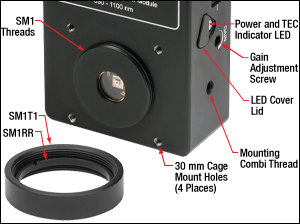
Click to Enlarge
The SPDMA detection module has external SM1 threads, is 30 mm cage system compatible, and includes an SM1T1 Internal SM1 Adapter and SM1RR Retaining Ring. The module also includes a gain adjustment screw and status LED with cover.
The detection module includes an SM1T1 SM1 coupler that adapts the external thread to an internal thread, an SM1RR retaining ring, and a reusable protective plastic cover cap. A power supply with a region-specific plug is also included with the module.

- Wavelength Range: 400 nm - 1000 nm
- Free-Space or FC/PC Connector Versions
- Maximum Dark Count Rate: 100 Hz or 250 Hz
- High Photon Detection Efficiency (See Table to the Right)
- Ø100 μm Active Detector (Nominal)
These SPDMHx Single Photon Detector Modules feature high photon detection efficiencies (PDEs) that extend into the NIR and low dark count rates, enabled by combining ultra-low-noise silicon avalanche photodiodes with specially developed quenching and signal processing electronics. Incoming photons generate corresponding electrical pulses that are converted into TTL pulses at the LEMO connector output. A LEMO to BNC adapter is included.
Versions are available with a maximum dark count rate of 100 Hz (Item #s SPDMH2 and SPDMH2F) or 250 Hz (Item #s SPDMH3 and SPDMH3F).
The detectors can be purchased in a free-space version (Item #s SPDMH2 or SPDMH3) that has internal SM1 (1.035"-40) threading for compatibility with Ø1'' lens tubes. We also offer versions with an FC/PC fiber optic receptacle that is pre-aligned to the detector, allowing a multimode fiber optic patch cable to be directly connected to the input (Item #s SPDMH2F or SPDMH3F).
For flexible integration into optical systems, there is an 8-32 tapped hole on each side of the input. The base plate of the detector can be mounted directly to an optical table or breadboard using CL4 Table Clamps. Alternatively, three Ø3.9 mm (Ø0.15") through holes on each side of the base plate accept 6-32 screws for compatibility with the BA4 mounting base. For the free-space detectors, we recommend mounting the BA4 mounting base to a 3-Axis translation stage or other positioning stage to enable precise alignment.
In order to avoid damage to the module, adequate heat sinking must be provided by placing or mounting the module onto a suitable heat sink, e.g. an optical table, breadboard or base plate. Avoid stray light impinging on the detector, which affects the count rate. Employ appropriate shielding for the SPDMH2 and SPDMH3 free space models and make sure that any optical fiber assembly attached to the FC/PC connector of the SPDMH2F or SPDMH3F modules shields unwanted light.
A power supply with a region-specific plug is included with each module.

| Item # | SPCNT |
|---|---|
| Power Supplya | |
| Connector | USB 2.0 |
| Voltage | 5 V |
| Current | 200 mA |
| Default Settings | |
| Bin Width | 500 ms |
| Dead Time | 0 ms |
| Threshold | 40% |
- Monitor Counts from Single Photon Detectors with Built in Display or PC
- Compatible with the SPDMA and SPDMHx Single Photon Detectors Single Photon Detectors
- Monitor and Save Results with Optical Power Monitor Software
- Monitor Output Connects to External Counters or Oscilloscope
- TRIG IN Connector to Gate via TTL signal
- Input Signals up to 100 MHz
Thorlabs' SPCNT Single Photon Counting Device recognizes signal pulses originating from a connected single photon detector. The results are shown numerically as counts or frequency on the built in display or sent to a connected PC for display and analysis. The SPCNT counter is compatible with Thorlabs' SPDMA single photon detector with adjustable gain and the SPDMHx series of detectors series of detectors with fixed gain.
The SPCNT counter can be operated with or without a PC connection. When the SPCNT counter is connected to (and powered by) the PC via the USB 2.0 port (USB type A to mini-B cable included), the device can be controlled by Thorlabs' Optical Power Monitor (OPM) software, which can also monitor and save counting results - see the Software tab for details. When the SPCNT counter is directly operated without connection to a PC, the device must be powered by an external power supply. Please see the table on the right for the required power supply specifications. Thorlabs' DS5 power supply is recommended. While operating without a PC connection the default settings shown in the table are applied to the SPCNT photon counter.
The monitor output SMA connection provides access to the pulses of the input signal for use with an external counter or oscilloscope. The monitor output signal is not identical to the input signal, as the Schmitt Trigger compares the pulse input with a configurable threshold, above which the signal is counted. See chapter Operating Principle in the SPCNT device manual for details.
The SPCNT counter can be operated in Gated mode where an external active high TTL signal can be applied to define the bin width or dead time with external hardware such as a signal generator.
The ECM100 or ECM225 Aluminum Side Clamps can be used to securely mount the SPCNT counter conveniently in the laboratory.

- Integrated Counter and Software Included
- Wavelength Range: 350 nm - 900 nm
- Compact Size: 85.0 mm x 76.5 mm x 36.2 mm
The SPCMxxA(/M) Single Photon Counting Modules convert an incoming photon to a TTL signal in the detector, which is then counted by an internal 31 bit counter. The module includes a software package with GUI for out-of-the-box operation. For more details about the software and its operation modes, please see the Software tab.
For flexible integration into optical systems, the detection module has external SM1 (1.035"-40) threading for compatibility with Ø1'' lens tubes. The SPCM20A(/M) provides an active area of Ø20 µm while the SPCM50A(/M) offers Ø50 µm. Two versions of each module are available for mounting in metric or imperial systems.
The module comes with a CD with the operating software, a USB 2.0 cable, Type A to mini Type B, and a power supply.
 Products Home
Products Home












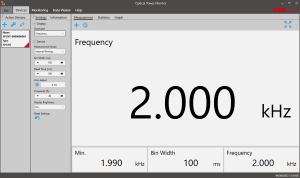
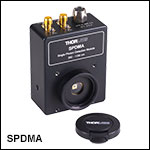
 Zoom
Zoom

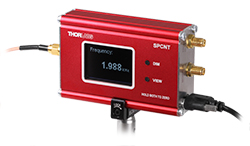
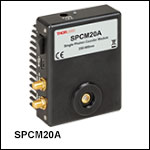
 Single Photon Detectors
Single Photon Detectors